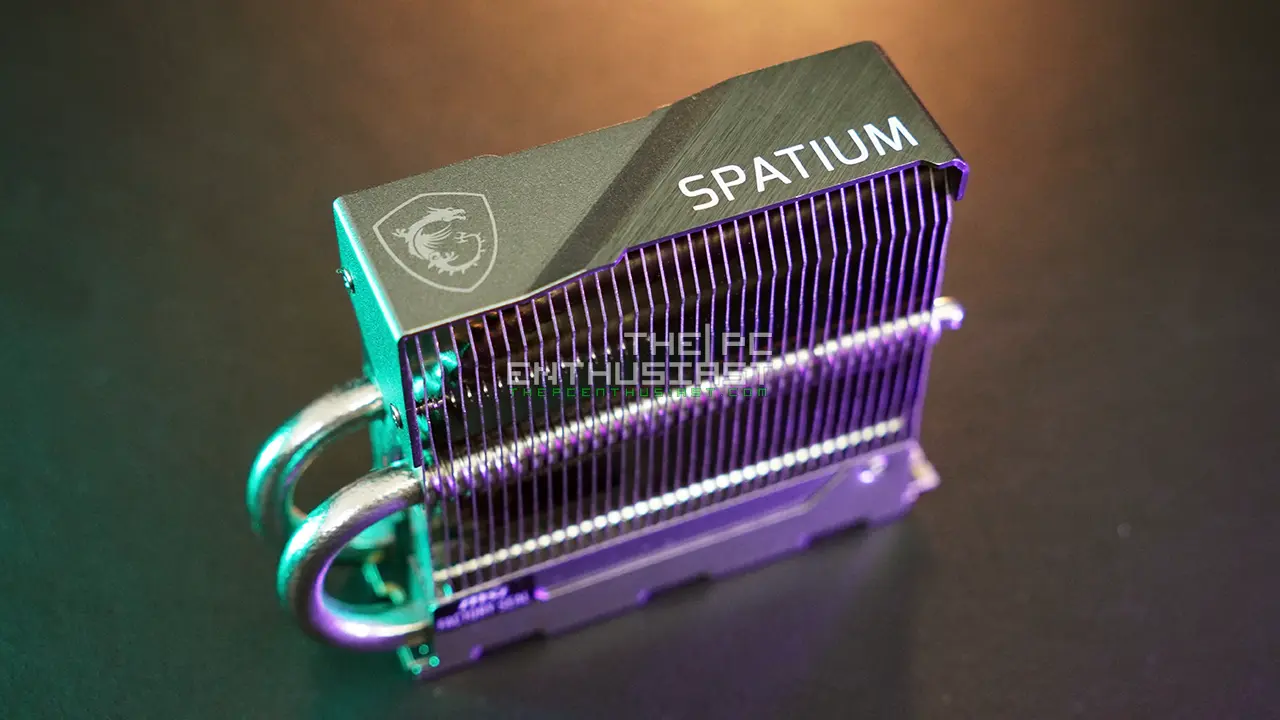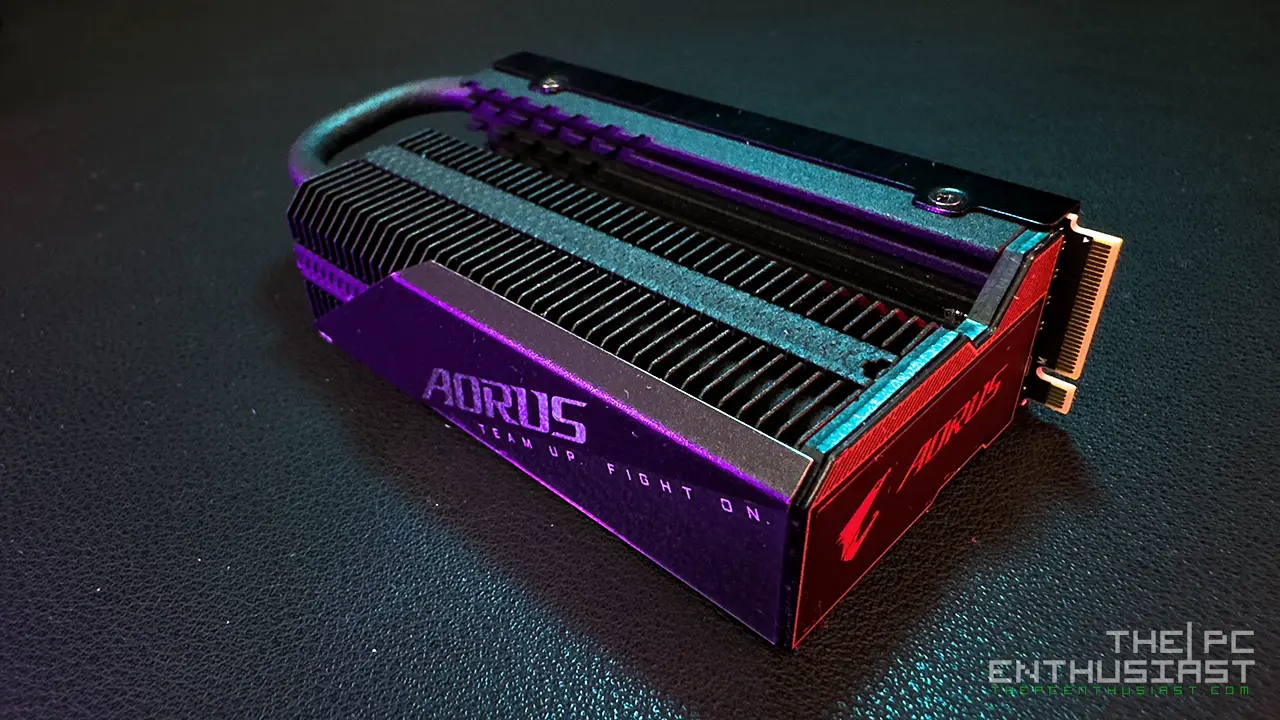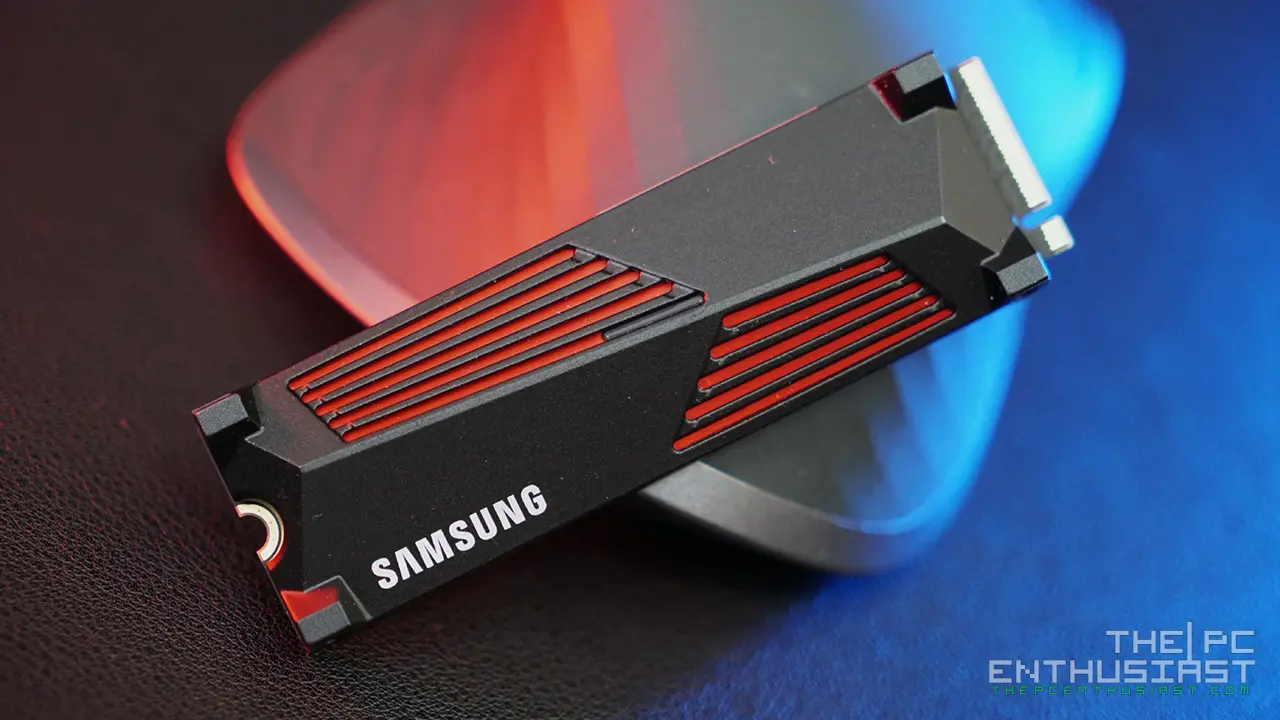Large-capacity SSDs are slowly replacing hard disk drives. While HDDs are still cheaper in terms of price/GB, SSD prices are getting cheaper as well, thanks to NAND technology advancement. A 2TB or 4TB SSD used to cost a lot of money a few years ago. Thanks to QLC NAND, there are now “cheaper” 2TB, 4TB, or even 8TB SSDs. Today, we will be checking out Sabrent’s Rocket Q4 NVMe Gen4 SSD with Heatsink. It’s not as fast as the Rocket 4 Plus we reviewed before, but it is cheaper while still offering fast and read-write speeds. If you are in the market for a fast and large-capacity SSD, please continue reading our Sabrent Rocket Q4 4TB review below.
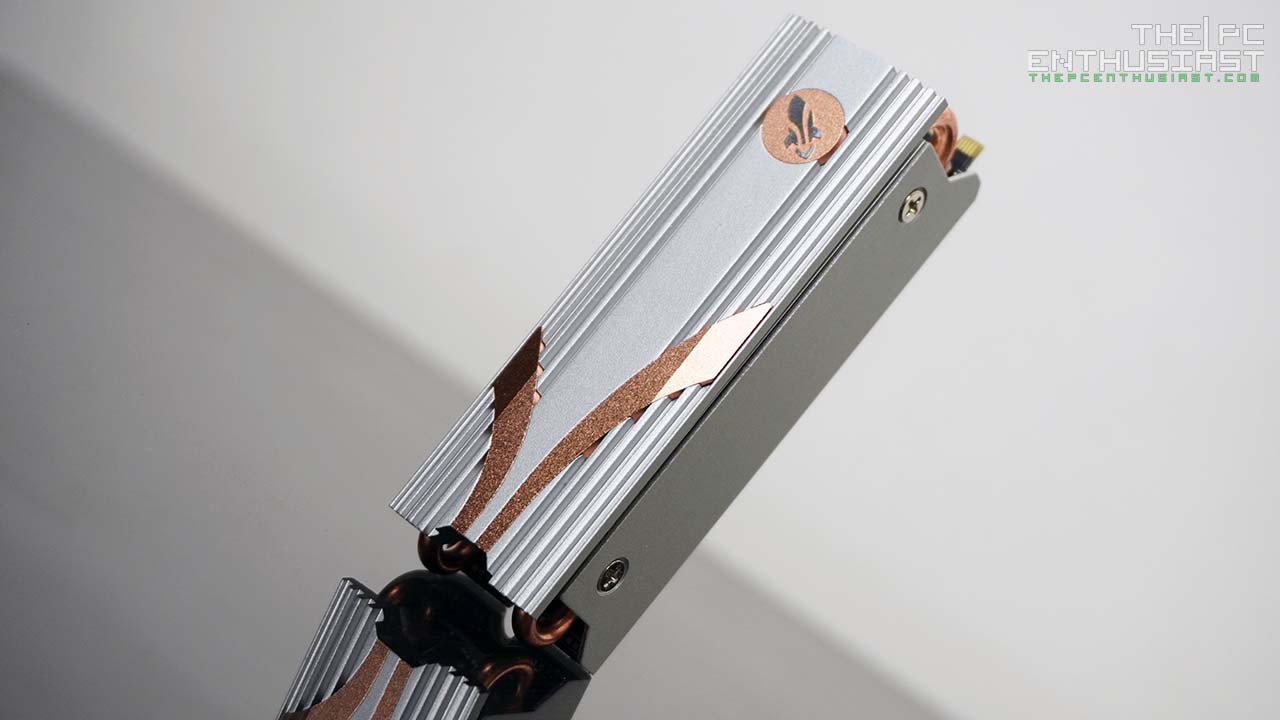
Sabrent Rocket Q4 NVMe PCIe 4.0 with Heatsink 4TB SSD Review
The Rocket Q4 NVMe PCIe 4.0 is Sabrent’s newer Gen4 SSD based on Phison’s E16 controller. It is not as fast as the Rocket 4 Plus that we previously reviewed, but it is cheaper since it is using a QLC NAND flash.
Its performance is similar to that of a first-generation Gen4 NVMe SSD. The Rocket Q4 offers a sequential read speed of up to 4,900MB/s and a sequential write speed of up to 3,500MB/s. Or a random read speed of up to 350,000 IOPs and a random write speed of up to 700,000 IOPs.
So, yes, it doesn’t have a blazing speed of up to 7,000MB/s like the Rocket 4 Plus. But up to 4,900MB/s of speed is no slouch either. That is still significantly faster than a hard disk drive or any SATA-based SSD, including PCIe 3.0 NVMe SSDs.
Speaking of PCIe 3.0, since the Rocket Q4 is based on the PCIe Gen4x4 interface, you do need a motherboard and processor that supports PCIe Gen4. For example, AMD’s Ryzen 3000 to 5000 processors and X570 or B550 motherboards. For Intel, it must be at least an 11th Gen Core i5 processor and a Z590 motherboard, or Intel’s latest Z690 with 12th Gen Alder Lake CPUs.
The Rocket 4 Plus is backward compatible with the PCIe 3.0 interface, but its speed will be limited to around 3,300MB/s sequential read and 3,300MB/s sequential write. There’s no point in buying a Gen4 SSDs if you’re only going to bottleneck its speed. If you don’t have a compatible system, Sabrent has several PCIe 3.0 NVMe M.2 SSDs that you can choose from.
More Features
The Sabrent Rocket Q4 is PCIe 4.0 and NVMe 1.3 compliant. It also features power management support for APST, ASPM, and L1.2. Aside from those, it also supports SMART and TRIM commands, as well as ONFi 2.3, ONFi 3.0, ONFi 3.2, and ONFi 4.0 interface.
Like most high-end and top-of-the-line NVMe SSD, the Rocket Q4 has an advanced wear-leveling feature; bad block management; error correction code, and over-provision. Its firmware is also upgradeable. Sabrent has the Rocket Control Panel for reviewing certain aspects of your Rocket drive; from checking drives health to upgrading drive firmware.
Aside from the Control Panel, Sabrent also offers the Sector Size Converter (SSC) that allows users to change the drive’s sector size. And finally, a free Acronis True Image utility.
Below are the rest of the specifications of the Rocket Q4 Plus.
Sabrent Rocket Q4 Plus Specifications
| 1TB | 2TB | 4TB | |
|---|---|---|---|
| Model (with HS) Model (no HS) | SB-RKTQ4-HTSS-1TB SB-RKTQ4-1TB | SB-RKTQ4-HTSS-2TB SB-RKTQ4-2TB | SB-RKTQ4-HTSS-4TB SB-RKTQ4-4TB |
| Form Factor | M.2 2280 | M.2 2280 | M.2 2280 |
| Interface | PCI-Express 4.0 x4, NVMe 1.3 | PCI-Express 4.0 x4, NVMe 1.3 | PCI-Express 4.0 x4, NVMe 1.3 |
| Controller | Phison PS5016-E16 | Phison PS5016-E16 | Phison PS5016-E16 |
| Total Capacity | 1000GB | 2000GB | 4000GB |
| NAND | Micron N28 96L QLC | Micron N28 96L QLC | Micron N28 96L QLC |
| External DDR Cache | SK Hynix DDR4 DRAM 4Gbx2 | SK Hynix DDR4 DRAM 8Gbx2 | SK Hynix DDR4 DRAM 8Gbx2 |
| Sequential Read speed | Up to 4700 MB/s | Up to 4850 MB/s | Up to 4950 MB/s |
| Sequential Write speed | Up to 1850 MB/s | Up to 3600 MB/s | Up to 3550 MB/s |
| Random 4K Read IOPS | up to 180k | up to 350k | up to 350k |
| Random 4K Write IOPS | up to 450k | up to 700k | up to 700k |
| Power Consumption R/W | R 5.6/W 5.7 (W) | R 6.3/W 6.8 (W) | R 6.8/W 7.6 (W) |
| Power Supply | 3.3V | 3.3V | 3.3V |
| Operating Temperature | 0~70° Celsius | 0~70° Celsius | 0~70° Celsius |
| Storage Temperature | -40~85° Celsius | -40~85° Celsius | -40~85° Celsius |
| Shock Resistant | 1500G | 1500G | 1500G |
| Data Correction | LDPC | LDPC | LDPC |
| Endurance | 200 TBW | 400 TBW | 800 TBW |
| Warranty | 5 years with registration 1 year without | 5 years with registration 1 year without | 5 years with registration 1 year without |
Packaging and Closer Look



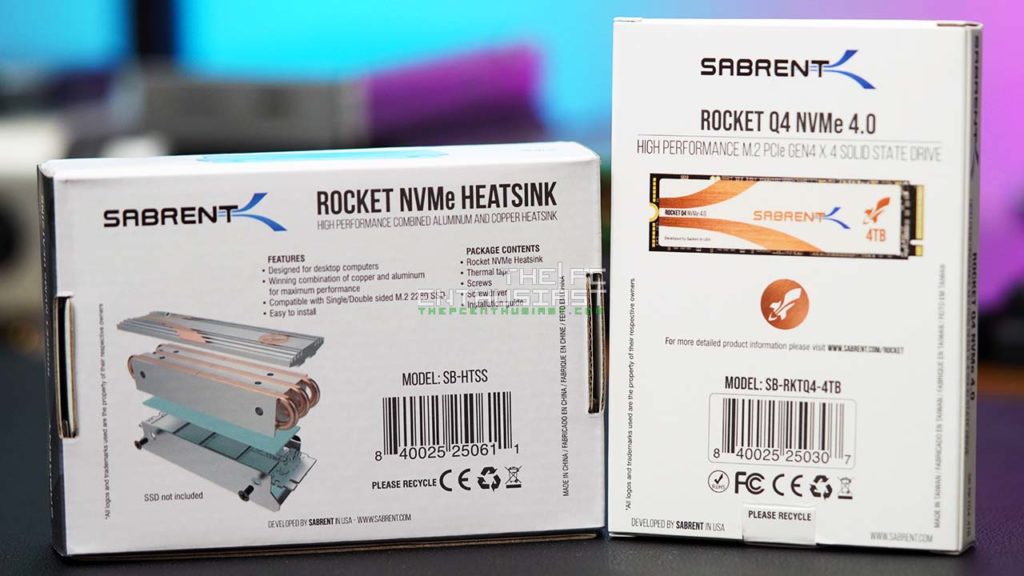
The Rocket Q4 that we have here is the with heatsink variant. So, its packaging is a little bit different compared to the without heatsink variant. Both the NVMe SSD and the heatsink’s package are held by a sleeve cover. The Rocket’s heatsink has its box, while the Rocket Q4 also gets a separate box.
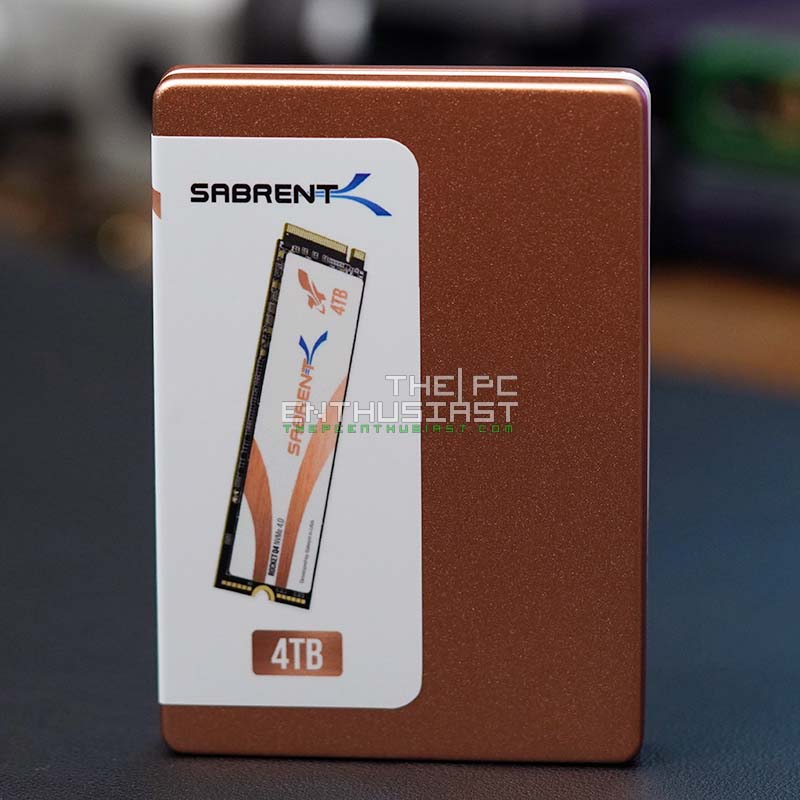
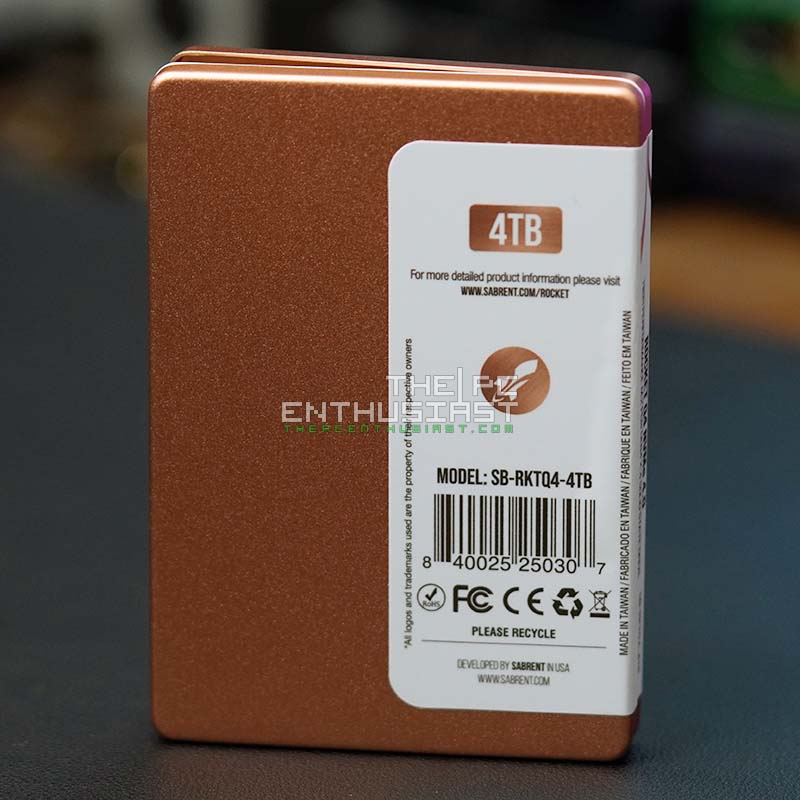


Just like with the Rocket 4 Plus, the Rocket Q4 drive is also housed inside a metallic case with a copper finish. It’s a small and very compact case and it includes reading material for the Q4. Meanwhile, inside the heatsink’s box are the heatsink itself, four screws for the heatsink, and another screw for mounting the SSD on the motherboard. There’s also a screwdriver in case you don’t have one at home.
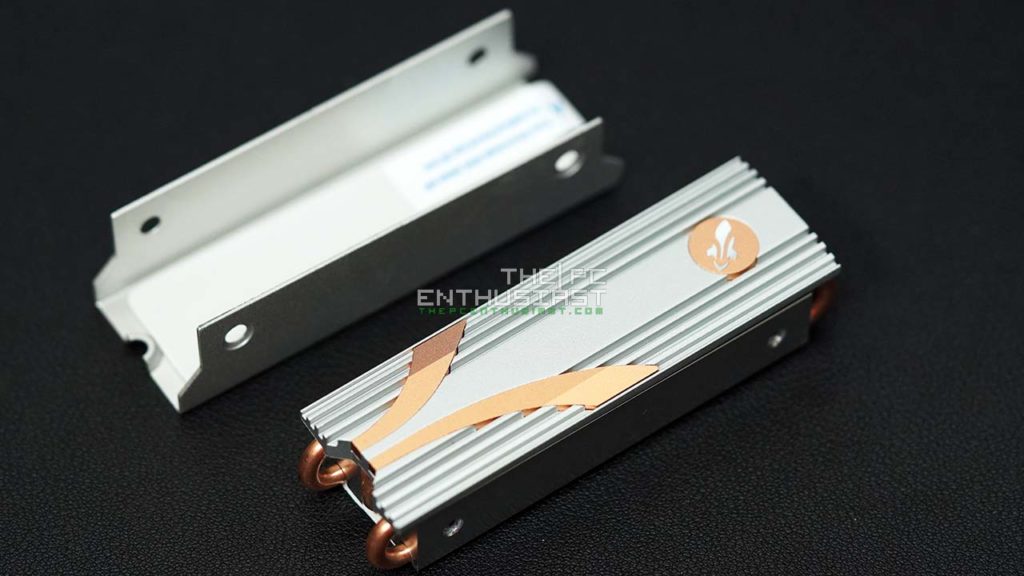

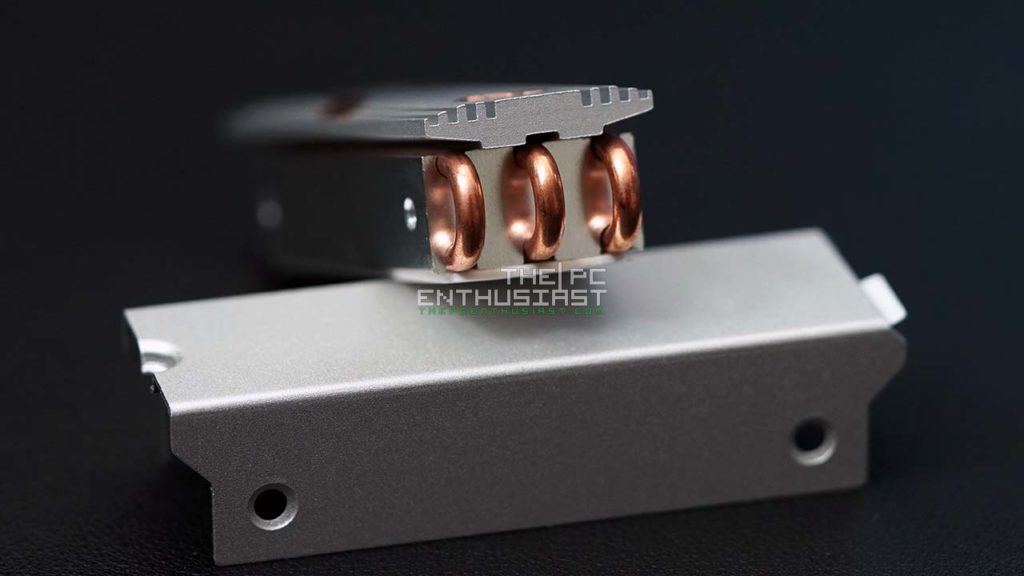
The Rocket’s heatsink is composed of two parts; the upper heatsink with small copper pipes, and the lower portion for the underside of the SSD. You will have to screw the top and bottom portion so that it won’t slide off accidentally.



Above you can see the front and rear view of the Sabrent Rocket Q4 NVMe 4TB capacity. There are only four 96-layer NAND chips from Micron in the Rocket Q4. Each chip is around 1TB in capacity for a total of 4TB. There are also two SK Hynix DRAMs, one in front and the other at the back.
The Phison PS5016-E16 controller is located at the (top) front portion, and it is hidden underneath the Sabrent Rocket Q4’s (sticker) label.
Sabrent Rocket Control Panel



Sabrent has two proprietary software, the Sector Size Converter and Control Panel. The SSC enables users to change the drive’s sector size. This is necessary under certain data cloning scenarios. Speaking of cloning, you can also download the Acronis True Image from Sabrent’s download page.
Meanwhile, the Control Panel (screenshots above), is the typical SSD utility. This tool allows users to review certain aspects of the Rocket driver. For example, checking the drive’s health, benchmarking, or upgrading the drive’s software.
These tools are not required to be installed, but you can use these utilities when needed. Now, let’s see how the Rocket Q4 performs.
The Test Setup
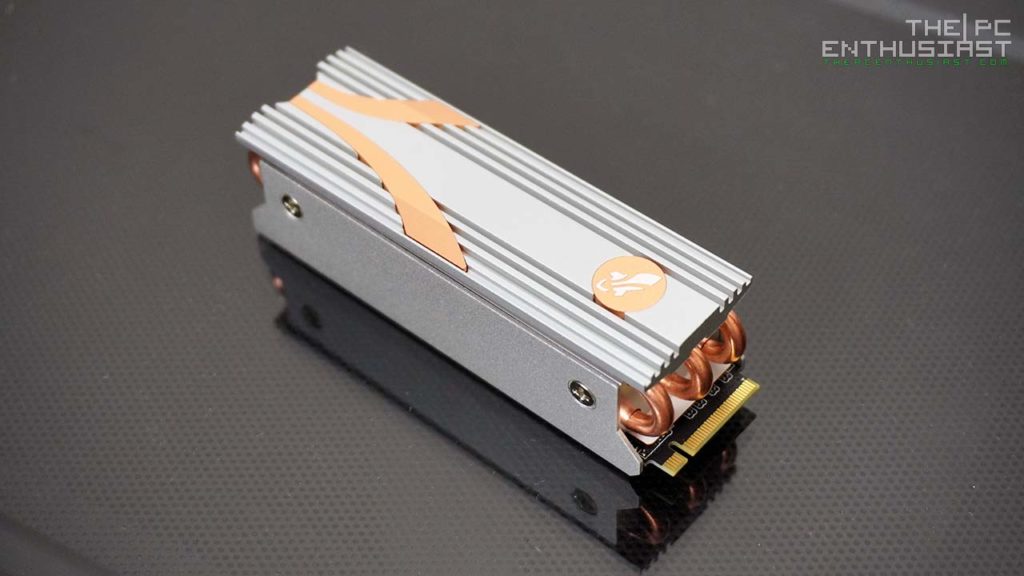
I tested the Sabrent Rocket Q4 on an AMD X570 system, powered by a Ryzen 7 5800X. The drive was installed on the first M.2 slot. It is the slot that is connected to the CPU, and the slot itself is located just below the CPU socket and right above the first PCIe x16 slot. Below are the rest of the system’s specifications:
| Operating System | Windows 10 Pro 64bit |
| Processor | AMD Ryzen 7 5800X |
| Motherboard | Gigabyte X570s Aorus Master |
| Memory | Klevv Cras XR RGB DDR4-4000 |
| Graphics Card | MSI GeForce RTX 3080 Ti SUPRIM X |
| OS Drive | Sabrent Rocket 4 Plus NVMe Gen4 SSD |
| Power Supply | SilverStone SX1000 Platinum SFX-L 1000W PSU |
| Chassis | Lian Li O11 Dynamic Mini |
Sabrent Rocket Q4 NVMe 4TB Benchmark Results
I also used the included heatsink of the Rocket Q4. I didn’t use the heatsink included with the Aorus X570s. This is, after all, a review of the Rocket Q4 with the heatsink variant. I noticed that without a heatsink, Gen4 SSDs tend to run hot and there is some throttling, especially during a prolonged test. So, if ever you plan on getting a Gen4 SSD that doesn’t come with a heatsink, be sure to utilize the motherboard’s heatsink for the M.2 drives, if available.
AJA Benchmark Results
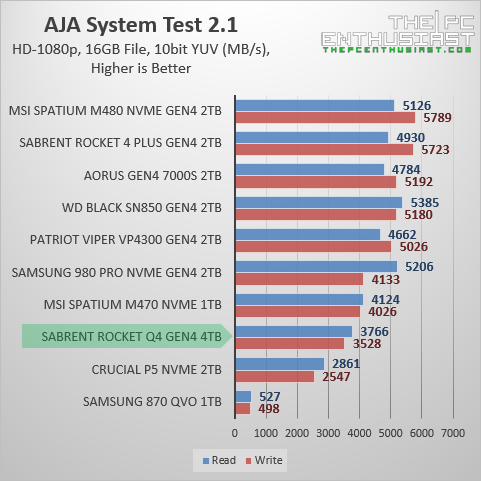
In the AJA System Test, the Rocket Q4 got around 3,500MB/s to 3,700MB/s of sequential write and read speeds, respectively. Although the Q4 was released recently, its relative performance is comparable to the first-gen NVMe Gen4 drives. Most of the Gen4 drives you see above, except the M470, are all second-generation NVMe drives. They are expected to be faster since their advertised speed is around 7,000MB/s. Meanwhile, the Samsung 870 QVO is a SATA-based SSD.
AS SSD Benchmark Results

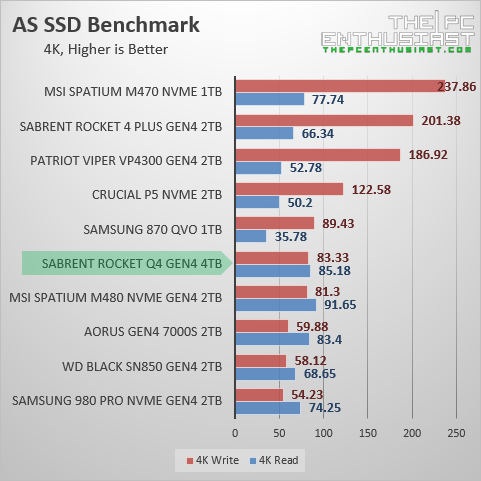
The Rocket Q4’s advertised speed is up to 4,900MB/s in sequential read and up to 3,500MB/s in sequential write. In the AS SSD benchmark, the Rocket Q4 was able to reach its advertised speed. Meanwhile, it fell short on the sequential read speed.
When it comes to random read and write tests, the Rocket Q4 was able to outperform some of the second-gen NVMe Gen4 drives by a few MB/s. It’s not an impressive result, but it is no slouch either. It sits right in the middle of the stack.
ATTO Disk Benchmark Results
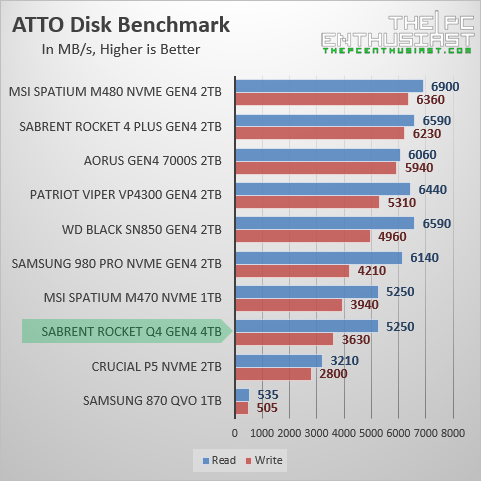
Using the ATTO Disk Benchmark, we can see that the Rocket Q4 4TB was able to reach and slightly surpass its advertised speeds. The drive got around 5,200MB/s sequential read speed and around 3,600MB/s sequential write speed.
CrystalDiskMark Benchmark Results
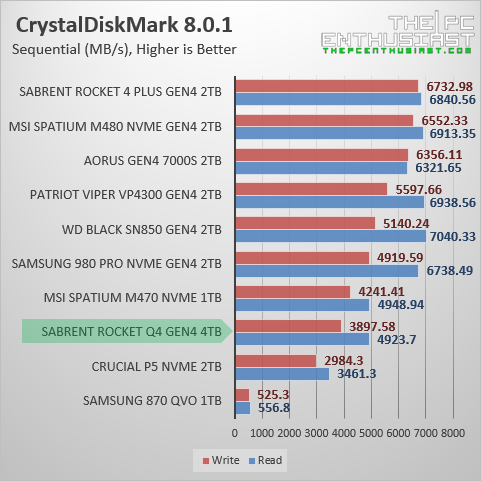
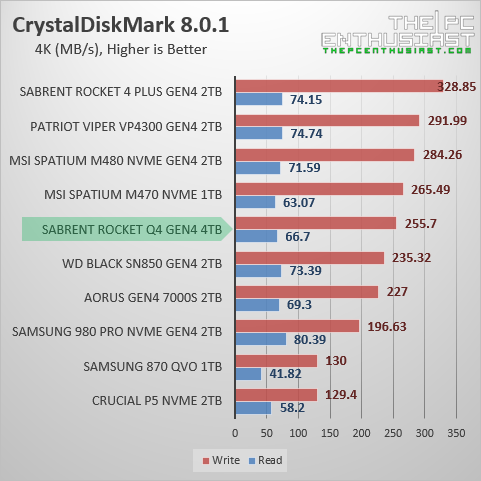
Again, in the CrystalDiskMark benchmark, the Rocket Q4 4TB capacity was able to hit both its sequential read and sequential write advertised speeds. Also, its 4K random performance wasn’t bad either in this test. It’s not the fastest but it’s not the slowest either. It sits right in the middle where I would expect a 1st gen NVMe Gen4 drive should be.
PCMark 10 Full System Drive Results
Last but not the least, I tested the Sabrent Rocket Q4 using PCMark 10’s Full System Drive benchmark suite. This is an intensive test and takes about an hour (or more) to finish. The test uses a wide-ranging set of real-world traces from popular applications (Adobe Creative Suite, Microsoft Office), and common tasks to fully test the performance of modern drives.
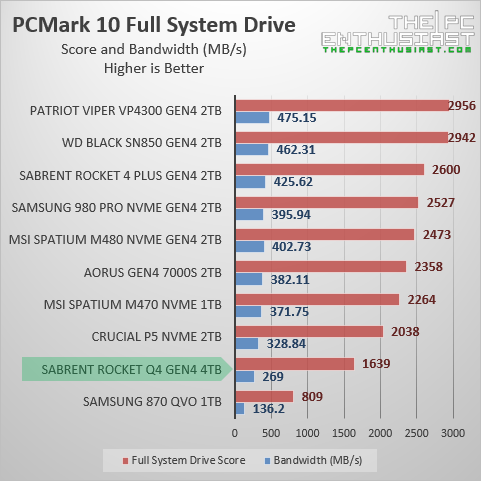
The results that I got for the Rocket Q4 in this test weren’t so impressive. I was expecting that it would get a better result and perhaps it would sit near the MSI Spatium M470. Its overall full system drive score was only 1639 and an overall bandwidth of only 269MB/s.
While the results that I got on the other test were good or as expected, this time it fell short a little bit. Perhaps it doesn’t perform well when the drive is used/active for a prolonged period. After all, the Full System Drive benchmark takes about an hour to complete the test.
Pricing and Availability
The Sabrent Rocket Q4 NVMe Gen4 SSD series is now available. It’s available in 1TB, 2TB, and 4TB capacities; and with heatsink and drive-only variants. Sabrent is also offering a 5-year limited warranty, with registration, for the said drive.
Sabrent Rocket Q4 NVMe Gen4 SSD Review Conclusion
The Sabrent Rocket Q4 4TB capacity performed as advertised; around 4,900MB/s sequential read and around 3,500MB/s sequential write. It’s not the fastest NVMe Gen4 drive out there, but it is within the expected speed. Generally speaking, the Rocket Q4 performance is similar to that of a 1st gen NVMe Gen4 SSD. And the Phison E16 controller is also common among 1st gen Gen4 SSDs.
Although, it’s not the fastest Gen4 drive, it is cheaper compared to 2nd gen Gen4 SSDs like the Rocket 4 Plus. Despite being “second fastest”, it’s still significantly faster than an HDD or even a SATA-based SSD. It’s also faster compared to Gen3 NVMe SSDs, and it’s somewhat “overkill” for purely gaming use, at least up until now.
The drive itself has a white sticker label, which will go well with a white-theme build. Otherwise, just put it under the motherboard’s heatsink if you don’t want it visible. The silver heatsink with copper accent looks nice as well.
I didn’t find anything alarming about the drive and it performs as expected. It does have a lower endurance rating (TBW) compared to other drives, like the Rocket 4 Plus. However, I don’t think it is a concern, especially if you are not doing some intensive writing on the drive. Its TBW is plenty enough for regular use and should at least last for 5 years or so. Sabrent guarantees the drive up to 5 years with registration.
Finally, while technically speaking it is still not a “cheap” drive at ~$700 for the 4TB capacity. It is still relatively cheap compared to the other 4TB NVMe SSD in the market. Again, with SSDs, the market is very competitive and the one with the most attractive pricing usually wins. Fortunately for Sabrent, not only do they offer attractive and competitive pricing, but their SSDs are of high quality as well.



